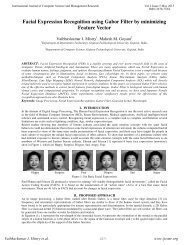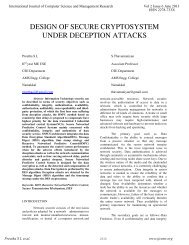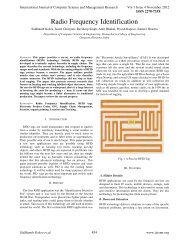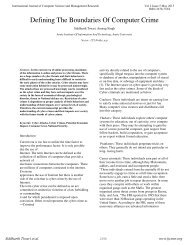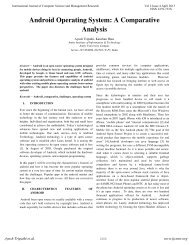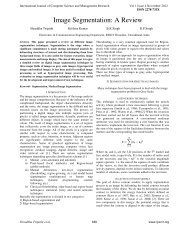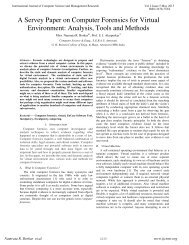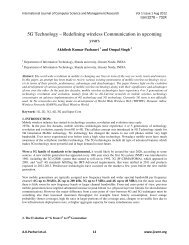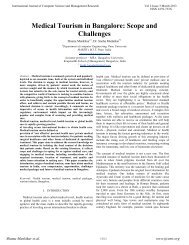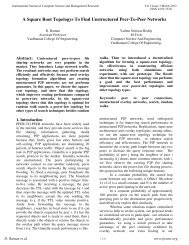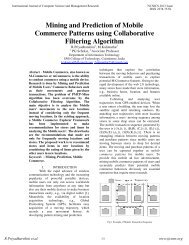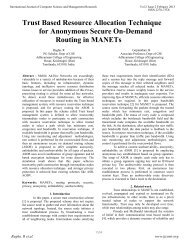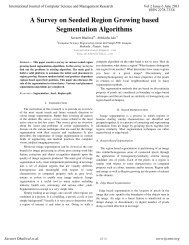segmentation techniques for image analysis: a review - ijcsmr
segmentation techniques for image analysis: a review - ijcsmr
segmentation techniques for image analysis: a review - ijcsmr
You also want an ePaper? Increase the reach of your titles
YUMPU automatically turns print PDFs into web optimized ePapers that Google loves.
International Journal of Computer Science and Management Research Vol 2 Issue 1 January 2013<br />
ISSN 2278-733X<br />
development of a unified approach to <strong>image</strong> <strong>segmentation</strong><br />
which can be applied to all type of <strong>image</strong>s, even the selection<br />
of an appropriate technique <strong>for</strong> a specific type of <strong>image</strong> is a<br />
difficult problem.[2][3]<br />
Based on different technologies, <strong>image</strong> <strong>segmentation</strong><br />
approaches are currently divided into following categories,<br />
based on two properties of <strong>image</strong>.<br />
• Detecting Discontinuities<br />
It means to partition an <strong>image</strong> based on abrupt changes in<br />
intensity, this includes <strong>image</strong> <strong>segmentation</strong> algorithms like<br />
edge detection.<br />
• Detecting Similarities<br />
It means to partition an <strong>image</strong> into regions that are similar<br />
according to a set of predefined criterion; this includes <strong>image</strong><br />
<strong>segmentation</strong> algorithms like thresholding, region growing,<br />
region splitting and merging.[3]<br />
CLASSIFICATION OF IMAGE SEGMENTATION METHODS<br />
Main<br />
Categories<br />
Edge Base<br />
<strong>segmentation</strong><br />
Region Based<br />
Special Theory<br />
Based<br />
Model Based<br />
Sub Classes<br />
Grey Histogram Technique<br />
Gradient<br />
Based<br />
Thresholding<br />
Region<br />
Operating<br />
Clustering<br />
Neural Network<br />
A. Segmentation Based on Edge Detection<br />
Differential coefficient<br />
technique<br />
Laplacian of a Gaussian<br />
Canny Technique<br />
Global Thresolding<br />
Local Thresolding<br />
Dynamic Adaptive<br />
Thresolding<br />
Region growing<br />
Region Splitting and<br />
Merging<br />
K-means<br />
Fuzzy<br />
Edge detection is currently becoming a problem of<br />
fundamental importance in <strong>image</strong> <strong>analysis</strong>, even if it is one of<br />
the different <strong>image</strong> <strong>segmentation</strong> <strong>techniques</strong>. In typical<br />
<strong>image</strong>s, edges characterize object boundaries, and are<br />
there<strong>for</strong>e useful <strong>for</strong> <strong>segmentation</strong> and detection of objects in a<br />
scene. [2][6]<br />
Edge detection is a term in <strong>image</strong> processing and computer<br />
vision, it refers to algorithms which aim at identifying points<br />
in a digital <strong>image</strong> at which there is an abrupt change in <strong>image</strong><br />
brightness or more <strong>for</strong>mally, has discontinuities or simply<br />
where there is a jump in intensity from one pixel to the next<br />
[6]<br />
There are many ways to per<strong>for</strong>m edge detection, however, the<br />
majority of different methods may be grouped into two<br />
categories:<br />
1. Gray Histogram Technique<br />
In this technique, <strong>segmentation</strong> depends upon the selection on<br />
threshold Thr. This method is very efficient as compared to<br />
other <strong>segmentation</strong> methods. Firstly depending upon the<br />
colour or intensity a histogram is calculated from the entire<br />
pixel in the <strong>image</strong>, and then edges and valleys in <strong>image</strong> are<br />
located. This method found difficult to use when significant<br />
edges and valleys in the <strong>image</strong>s were identified.[9][12]<br />
2. Gradient Based Method<br />
Gradient is the first derivative <strong>for</strong> <strong>image</strong> f(x, y), when there is<br />
abrupt change in intensity near edge and there is little <strong>image</strong><br />
noise, gradient based method works well. This method<br />
involves convolving gradient operators with the <strong>image</strong>. High<br />
value of the gradient magnitude is possible place of rapid<br />
transition between two different regions. These are edge<br />
pixels, they have to be linked to <strong>for</strong>m closed boundaries of the<br />
regions. Common edge detection operators used in gradient<br />
based method are sobel operator, canny operator, Laplace<br />
operator, Laplacian of Gaussian (LOG) operator & so on, [2]<br />
canny is most promising one , but takes more time as<br />
compared to sobel operator. Edge detection methods requires<br />
a balance between detecting accuracy and noise immunity in<br />
practice, if the level of detecting accuracy is too high, noise<br />
may bring in fake edges making the outline of <strong>image</strong>s<br />
unreasonable and if the degree of noise immunity is too<br />
excessive, some parts of the <strong>image</strong> outline may get undetected<br />
and the position of objects may be mistaken. Thus, edge<br />
detection algorithms are suitable <strong>for</strong> <strong>image</strong>s that are simple<br />
and noise-free as well often produce missing edges or extra<br />
edges on complex and noisy <strong>image</strong>s.[3]<br />
B. Region Based Segmentation Methods<br />
Edge-based <strong>segmentation</strong> partitions an <strong>image</strong> based on abrupt<br />
changes in intensity near the edges whereas region based<br />
<strong>segmentation</strong> partitions an <strong>image</strong> into regions that are similar<br />
according to a set of predefined criteria. Thresholding, region<br />
growing, region splitting and merging are the main examples<br />
of <strong>techniques</strong> in this category[8]<br />
1. Thresholding Method<br />
Thresholding <strong>techniques</strong> are <strong>image</strong> <strong>segmentation</strong>s based on<br />
<strong>image</strong>-space regions. The fundamental principle of<br />
thresholding <strong>techniques</strong> is based on the characteristics of the<br />
<strong>image</strong>. [5] It chooses proper thresholds n T to divide <strong>image</strong><br />
pixels into several classes and separate the objects from<br />
background. When there is only a single threshold T , any<br />
point (x, y) <strong>for</strong> which f (x, y)>T is called an object point; and<br />
a point (x, y) is called a background point if f (x, y)




